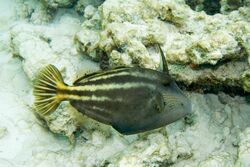Biology:Orangespotted filefish
| Orangespotted filefish | |
|---|---|

| |
| Scientific classification | |
| Domain: | Eukaryota |
| Kingdom: | Animalia |
| Phylum: | Chordata |
| Class: | Actinopterygii |
| Order: | Tetraodontiformes |
| Family: | Monacanthidae |
| Genus: | Cantherhines |
| Species: | C. pullus
|
| Binomial name | |
| Cantherhines pullus Ranzani, 1842
| |
The orangespotted filefish[2] (Cantherhines pullus) is a species of filefish described by Ranzani in 1842.[3] and it is native to shallow waters in the tropical and subtropical Atlantic Ocean, the Caribbean Sea and the Gulf of Mexico.
Description
The orangespotted filefish grows to a length of about 20 cm (8 in). The head has a number of wavy yellowish lines which run down onto the snout; near the eyes these alternate with bluish lines. The body has a number of broad brown bands separated by narrow whitish-yellow bands which converge at the caudal peduncle and continue onto the tailfin. On the caudal peduncle there is a moderate-sized white spot, often with a smaller white spot below it. The body is speckled with small orange spots, some of which have brown centres, and similar sized white spots. The first spine of the dorsal fin is located above the eye. It is very large and is separate from the rest of the fin. Immediately behind its base is a groove into which it can be folded when not needed.[2][4]
Distribution and habitat
The orangespotted filefish occurs in the Caribbean Sea, the northern half of the Gulf of Mexico and the tropical and subtropical waters of the Atlantic Ocean. In the western Atlantic, its range extends from Massachusetts to southeastern Brazil, while in the eastern Atlantic, it is known from São Tomé and the Gulf of Guinea. It is usually found on reefs at depths between about 3 and 50 m (10 and 160 ft), but usually no deeper than 20 m (70 ft).[2]
Ecology
The orangespotted filefish tends to swim near the seabed over rocky and coral reefs, hiding among the taller corals and gorgonians. It feeds mainly on sponges and algae, but also consumes tunicates, bryozoans and other bottom-dwelling invertebrates. Juveniles are found in the water column away from reefs and are preyed on by tuna, billfishes, and other large predatory fishes. This fish is held in low esteem by humans and seldom eaten by them.[2]
References
- ↑ Matsuura, K.; Tyler, J.; Robertson, R. (2015). "Cantherhines pullus". IUCN Red List of Threatened Species 2015: e.T16431606A115356802. doi:10.2305/IUCN.UK.2015-4.RLTS.T16431606A16510017.en. https://www.iucnredlist.org/species/16431606/115356802.{{cite iucn}}: error: |doi= / |page= mismatch (help)
- ↑ 2.0 2.1 2.2 2.3 Froese, Rainer and Pauly, Daniel, eds. (2020). "Cantherhines pullus" in FishBase. July 2020 version.
- ↑ Bailly, Nicolas (2008). "Cantherhines pullus (Ranzani, 1842)". WoRMS. World Register of Marine Species. http://www.marinespecies.org/aphia.php?p=taxdetails&id=159493.
- ↑ M. De Kluijver; G. Gijswijt. "Orangespotted filefish: Cantherhines pullus". Interactive Guide to Caribbean Diving. Marine Species Identification Portal. http://species-identification.org/species.php?species_group=caribbean_diving_guide&id=180. Retrieved 21 July 2020.
External links
- Photos of Orangespotted filefish on Sealife Collection
Wikidata ☰ Q777245 entry
 |


